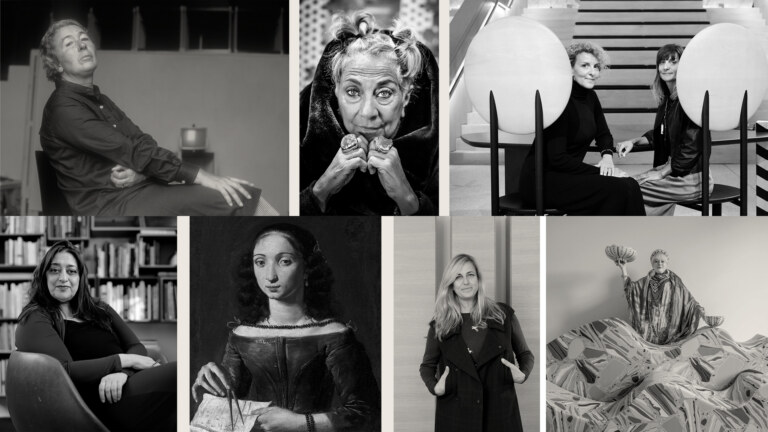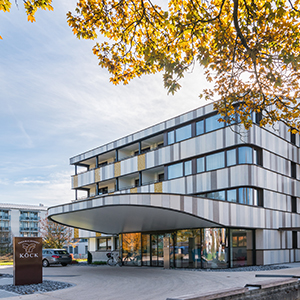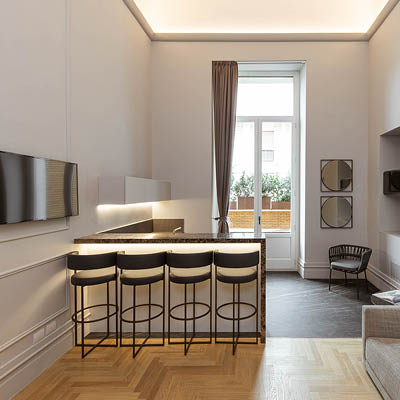
On the occasion of International Women’s Day (8th March), Laminam wants to celebrate women who have made history in architecture and design through their achievements and design thinking process. An inclusive approach to building capable of ambitious leaps and magnificence
When we think about the history of architecture, how many female architects come to mind?
In a discipline that, like many other arts, has been dominated by men for centuries, there is no shortage of women’s names. From archistars such as Zaha Hadid, to architects who have been involved in urban planning, designing private homes, council estates, gardens, public spaces, sanitary facilities, schools… women bring all their expertise and sensitivity to social issues.
Plautilla Bricci was the first to make a name for herself in Italy in the 17th century, a period marked by the Baroque style of Bernini and Borromini. An artist by birth, Bricci enjoyed an independence and freedom unimaginable for a woman of her time, as she never married or took vows. Bricci’s most famous work was the Villa Benedetta near the Porta San Pancrazio, better known as Villa del Vascello, for which she coordinated the work of colleagues such as the aforementioned Bernini, as well as Cortona and Grimaldi. A woman in charge of the work? The foreman was so scandalised that he threatened to leave. It was thanks to the abbot, assisted by a notary who drew up a document, that the workers were obliged to follow the instructions of Plautilla Bricci, who, to everyone’s amazement, was called “l’architettrice” (woman architect, in Italian) (L’architettrice is also the title of her fictional biography, written by Melania Mazzucco). When you hear it now, it seems like an incorrect term to use, but at the time it sounded like a small revolution. It was coined for Plautilla Bricci (a painter, before she became an architect) because there was no feminine noun, at the time, to define a female architect.
The challenges faced by women in the world of architecture often stem from anachronistic but entrenched stereotypes. It is not without reason that Gae Aulenti, another key figure in the architectural history of the last century, used to say: “Architecture is a man’s profession but I have always pretended not to know that”
Aulenti focused on interior architecture and design, furniture design, and space planning and design for exhibitions, showrooms and stages; her long and fruitful collaboration with Olivetti is particularly noteworthy. Her signature pieces include iconic items such as the Pipistrello table lamp, designed for the Olivetti showrooms in Paris and Buenos Aires and later mass-produced by Martinelli Luce. Today, we can also admire it at the MoMA in New York, where it is part of the permanent collections.
One of the most revolutionary figures in 20th century architecture was undoubtedly Lina Bo Bardi. Bo Bardi graduated in Rome with a dissertation on the design of a maternity hospital for unwed mothers. After working for a while in Milan, where she collaborated with Gio Ponti and became the deputy editor of Domus magazine, she moved to Brazil with her husband, Pietro Maria Bardi, in 1946. Bardi was the Founding Director of the São Paulo Museum of Art, but Lina was far from being the “wife of”. Thanks to buildings such as La Casa de Vidro – today the seat of the foundation dedicated to her – or the MASP, the São Paulo Museum of Art (still the most important in Latin America), or the Museum of Popular Art of Bahia, Bo Bardi’s contribution to the development of Brazilian architecture was fundamental.
Bo Bardi
Architects, designers and....archistars.
Thoughts are undoubtedly turning to Zaha Hadid, the first woman in history to win the Pritzker Prize (2004) and the Royal Institute of British Architects Gold Medal (2016). Hadid was convinced that architecture should instil pleasure and a sense of wonder. And what could be more extraordinary than her unforgettable buildings? Characterised by curved structures, dynamic lines and dilated forms, they are majestic architectures that reinterpret the concept of monumentality in a contemporary key.
The work of Zaha Hadid Architects, which employs more than 240 architects, includes the MAXXI in Rome, the futuristic London Aquatics Centre, the Vitra Fire Station in Weil am Rhein in Germany, the Guangzhou Opera House in China, as well as a shoe collection, a jewellery line and handbags for some of the biggest names in luxury fashion.
We are no longer talking strictly about architecture, but about industrial design, and here too, the contribution of women – in addition to Hadid’s – can boast important, sometimes still little-known names.
Let’s start with Charlotte Perriand, a French architect and designer who worked extensively with Le Corbusier and Pierre Jeanneret (but also with Fernand Léger, Jean Prouvé and Lucio Costa) and who signed some of the most prestigious projects of the 1920s. And what about Cini Boeri? Her extraordinary versatility in design won her the Compasso d’Oro in 1979 for the Strips modular sofa she designed for Arflex, a design bestseller that has found its way into the permanent collections of museums such as the Triennale in Milan and the MoMA in New York, as well as into the homes of fashion and film stars. Yet Boeri was keen to emphasise its humble, domestic and practical nature:
Cini Boeri
Other names of note
Other names of note include Patricia Urquiola, creative director of Cassina, who has worked on projects for the most important design brands, and Paola Navone, whose passion for imagination and colour dates back to the Alchimia group, where she trained with Sottsass, Mendini and Branzi, are also notable names. And then there is Studiopepe, aka Arianna Lelli Mami and Chiara Di Pinto from Milan, who have set out to conquer the world (aesthetically speaking) thanks to an unmistakable style that is surreal and dreamlike.
And let’s not forget all the creative women who bring together East and West, North and South, in a crossroads of cultures that promotes inclusion and relationships: India Mahdavi, Nina Yashar, and Bethan Laura Wood, for example. Theirs is a radiant mind and a feminine perspective with a vital, extraordinary energy.
Just like all those women who, whatever their profession, fill their lives every day with ideas, flair, and passion. Today is your day.





